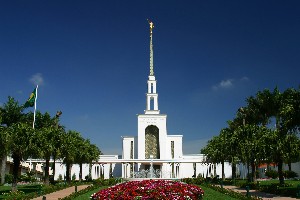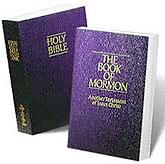
Robert Lippelt and his wife, Augusta, arrived in Brazil from Germany in 1923, when Augusta began asking Church headquarters for teaching materials to be sent to her. In response, South American Mission President Reinhold Stoff left Buenos Aires to visit Brazil. He returned in 1928, with missionary elders to teach the German-speaking people in the country. The first converts joined the Church in 1929.
The first Church-owned meetinghouse in South America was dedicated in Joinville on 25 October 1931. A Brazilian mission was created from the South American Mission in May 1935. Church teaching materials were translated into Portuguese in 1937, and missionaries began teaching in Portuguese a year later.
Missionary efforts continued in the 1950s, and by 1959, membership was about 3,700. Brazil's first stake (diocese) was organized in 1966 in São Paulo, consisting of seven wards and three branches; the president was Walter Spät. The story of President Spät was printed in the Ensign in 1990.
Ten years later, Brazil had 10 stakes, and a temple was announced for São Paulo. That temple was dedicated on October 30, 1978 by President Spencer W. Kimball.

On February 2, 1986, Brazil became the third country outside the United States to have 50 stakes. That number doubled to 100 by 1993 with the organization of the São Leopoldo Stake. It took 62 years for the first 56 stakes to be formed; but the next 50 were formed in just three years. Portuguese is now the third most spoken language in the Church.
In October of 1993, construction began on Brazil's new Missionary Training Center, the Church's second largest, which was dedicated in March of 1997. Nowadays, with 26 missions, Brazil has the largest number of missions outside the United States.
President James E. Faust is one of the most devoted of Brasil's supporters in the Church. He served as a missionary in the Brasil mission for a total of 33 months, from 1939-1942. His mission was extended when he couldn't return home because of World War II which was ongoing.
The first native Brazilian to be called as a general authority was Hélio da Rocha Camargo, who was sustained to the First Quorum of Seventy on April 6, 1985. He was changed to the Second Quorum when it was formed in 1989, and then released in October 1990. Helvécio Martins served as a member of the Second Quorum of Seventy from 1990 to 1995. He was the first afro descendent man to be sustained as a General Authority in the history of the Church. Currently, there are two brazilian leaders serving as General Authorities: Claudio Roberto Mendes Costa (First Quorum of the Seventy), Adhemar Damiani (Second Quorum of the Seventy).
The Church also has a substantial history of involvement in humanitarian efforts in Brazil.
Temples
|

